1. Revisiting My Community

After the feedback session, I redefined my focus to the LSBU Sports Hall badminton community a place that truly represents my personal and cultural sense of belonging in London.
Badminton is more than a sport for me; it’s a way to connect emotionally, socially, and culturally. The rhythm of rallies, the sound of the shuttle, and the synchronised movement of players form a shared language of belonging.
As an international student, this community gives me a sense of home. It reminds me that belonging is not fixed by place or language, but by rhythm, participation, and shared presence. Through play, I experience both grounding and release a balance between personal focus and collective energy.
2. Observation and Sensory Mapping

Using sensory ethnography, I documented how belonging is expressed through five sensory and behavioural categories: sound, light/space, movement, emotion, and social interaction.
Key Findings
- Sound: overlapping hits, squeaks, and calls form a rhythmic soundscape a mix of focus, chaos, and familiarity.
- Light / Space: bright fluorescent lighting energises but also compresses the visual field.
- Movement / Rhythm: rallies produce both physical connection and social hierarchy speed signifies belonging.
- Emotion / Belonging: comfort comes from familiarity and repetition; small in-groups form through routine.
- Social Interaction: conversation between matches and small gestures like passing shuttles act as unspoken rituals of inclusion.
Insight: Belonging in this community is not spoken but performed through rhythm, gesture, and timing.
The same rhythm that unites experienced players can also isolate newcomers who can’t yet “read” the pace of the hall.
3. Community Insights and Voices
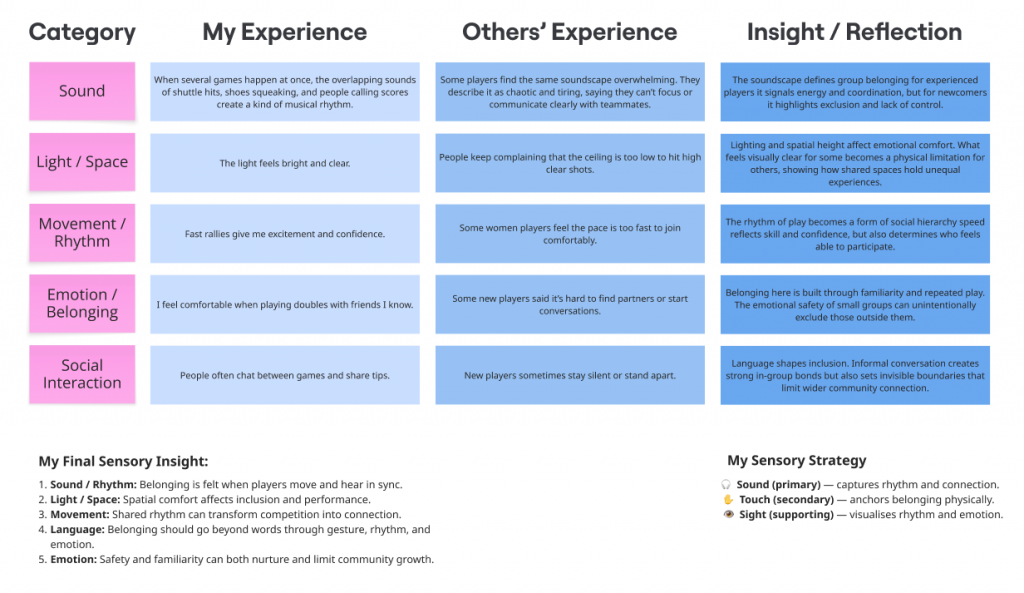
Through short conversations with players from Monday, Thursday, and Sunday sessions, I found that the badminton community’s sense of belonging is rhythmic and situational rather than stable.
Least-heard voices
Quiet or transient members those who join alone or move between clubs often remain unnoticed, even though their quiet participation still contributes to the hall’s rhythm.
Expression of belonging
Players connect through movement and coordination more than through language. Laughter, rallies, and small gestures build inclusion; belonging emerges through shared timing rather than speech.
Community perception
1. You can recognise someone’s play by sound.
2. The airflow by the side door is the best place to rest.
3. The ceiling’s too low for clear shots.
These comments reveal how physical space, rhythm, and interaction intertwine. The environment itself choreographs belonging it dictates pace, comfort, and visibility within the group.
5. Reframing Insight
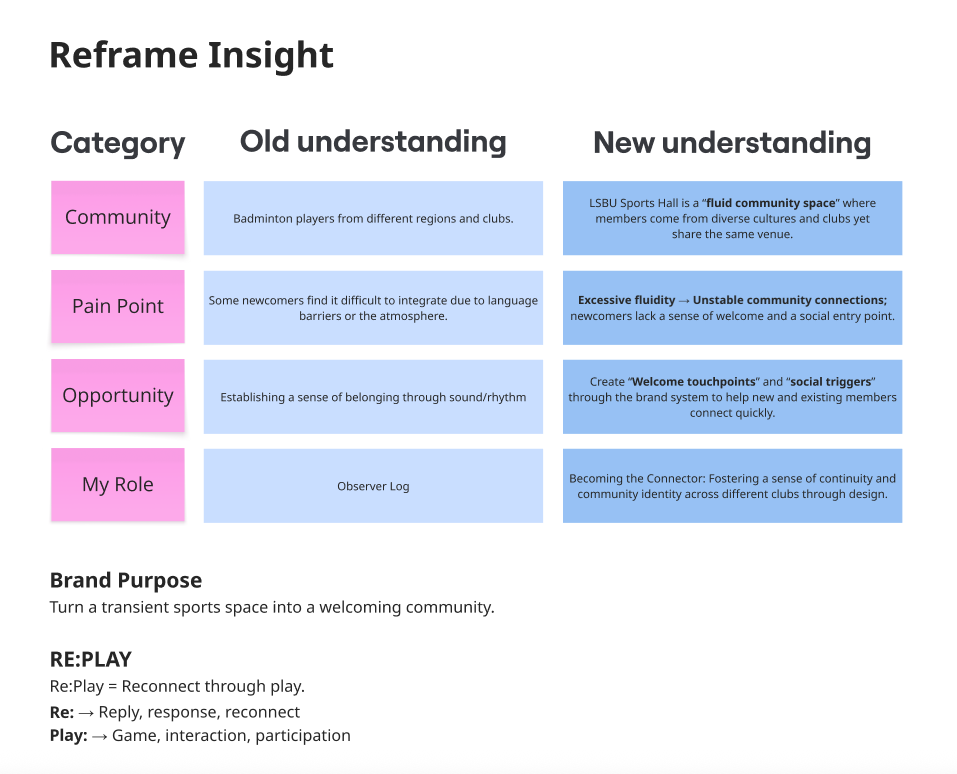
This reframing clarified the purpose of my design: to transform a transient sports space into a welcoming community.
6. Brand Concept Development from Idea to Re:Play
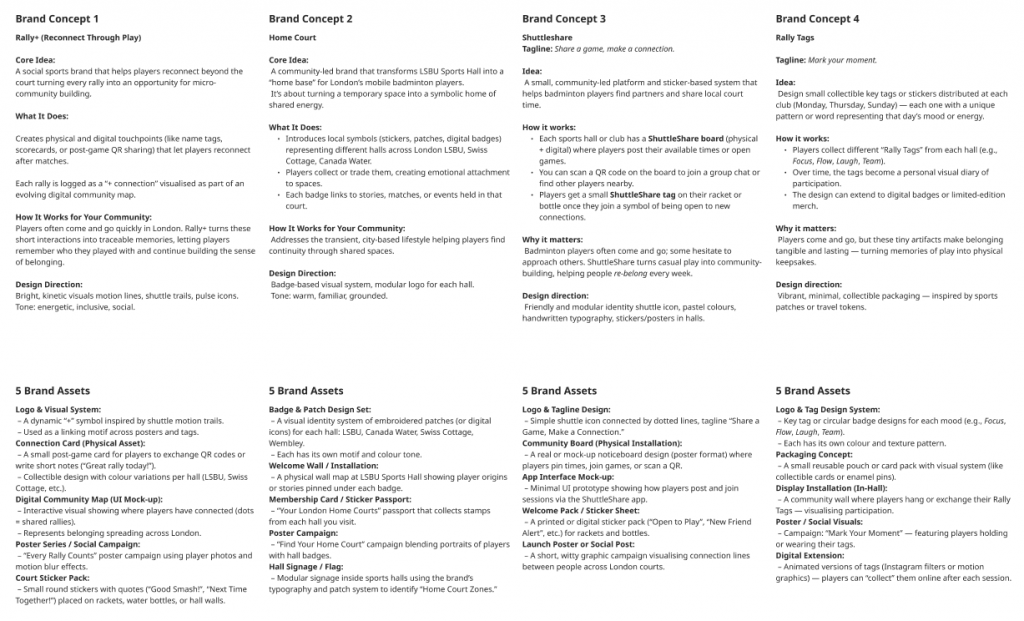
I explored several directions during concept ideation Rally+, ShuttleShare, Home Court, and Rally Tags each testing how visual design can translate connection through motion.
After feedback, I selected Rally Tag as the foundation because it embodies the physicality of play and turns invisible connections into tangible memory objects.

The final brand name emerged as RE:PLAY, built from two ideas:
Re: reply, response, reconnect
Play: game, interaction, participation
Together, Re:Play symbolises the repetitive, rhythmic nature of community life belonging that is reconstructed every time people meet to play.
7. Brand Concept: Re:Play connect through Motion
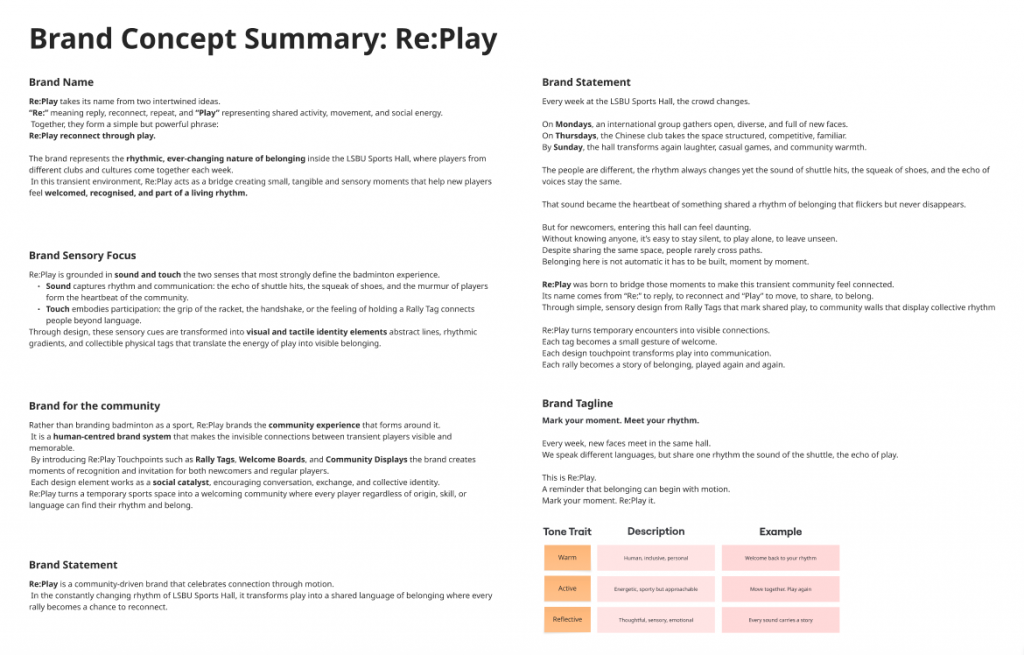
Brand Purpose
To transform a transient sports hall into a welcoming and connective community, where every game becomes a chance to reconnect.
Brand Statement
Re:Play is a community-driven brand that celebrates connection through motion.
In the constantly changing rhythm of LSBU Sports Hall, it transforms play into a shared language of belonging where every rally becomes a moment to mark, remember, and reconnect.
Sensory Focus
- Sound captures rhythm and communication: the echo of shuttles, the squeak of shoes, the murmur of players.
- Touch embodies participation and physical connection the grip of the racket, handshake, or collecting a tag.
Through design, these sensory cues are translated into visual and tactile identity elements abstract lines, rhythmic gradients, and collectible physical tags.
8. Brand Assets

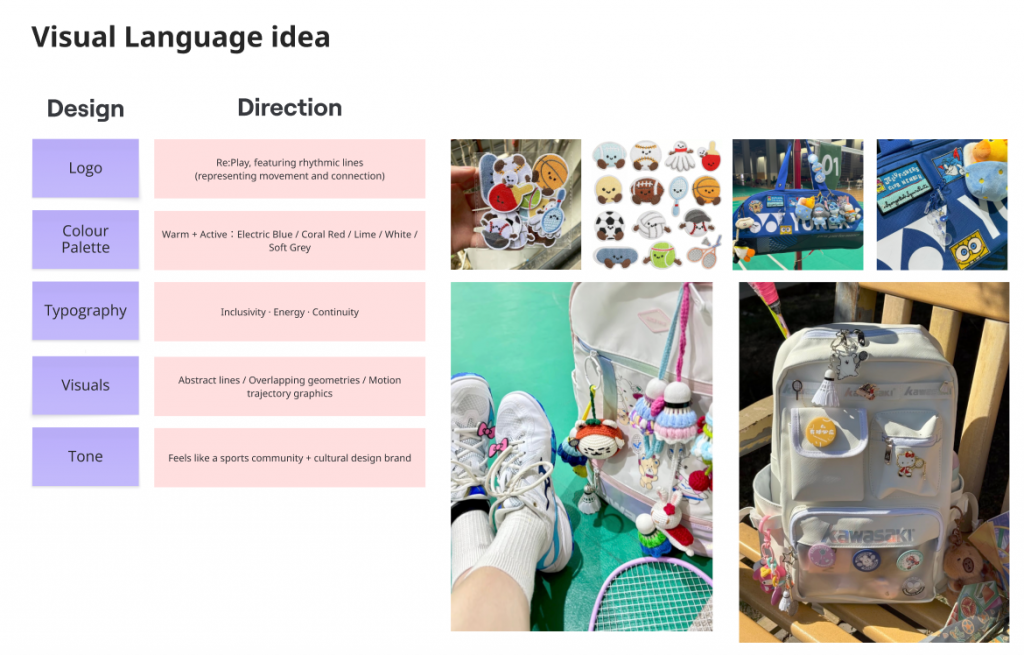
1. Logo & Tag System
A collectible tag series forms the core of Re:Play’s identity.
Each week’s session releases a fabric sticker—R, E, P, L, A, Y—with the “:” tag as a limited edition.
Players attach them to their badminton bags, gradually spelling RE:PLAY as they attend more sessions.
Completing the full set unlocks a free session transforming participation into playful motivation.
2. Packaging Design
A reusable fabric pouch allows players to store and display their tags. It serves as both a tactile keepsake and a record of community presence.
3. Animation for Sports Hall Display
A looping animation of rhythmic lines and shuttle trails projected inside LSBU Hall acts as a digital pulse of belonging, reminding players that every rally adds to the shared rhythm.
4. Posters & Social Visuals
Three main posters communicate Re:Play’s tone:
- Mark your moment. Meet your rhythm.
- Welcome to our community.
- Scan. Join. Re:Play.
These are adapted for social media and digital screens to attract new members.
5. Digital Extension
An Instagram page and WhatsApp group allow players to connect between sessions bridging online continuity and offline participation.
9. Reflection
Re:Play taught me how methodology can evolve into brand strategy. What began as sensory observation of light, sound, and rhythm developed into a systemic understanding of community dynamics.
Through ethnography, mapping, and reframe, I learned that design can act as a connector turning motion, sound, and shared space into a collective identity.
Belonging is dynamic, not static.
It happens in rhythm, repetition, and the moments when people play together again.
This project helped me see myself not just as a designer but as a translator between movement and meaning, using visual and sensory design to make invisible social bonds visible.
Leave a Reply